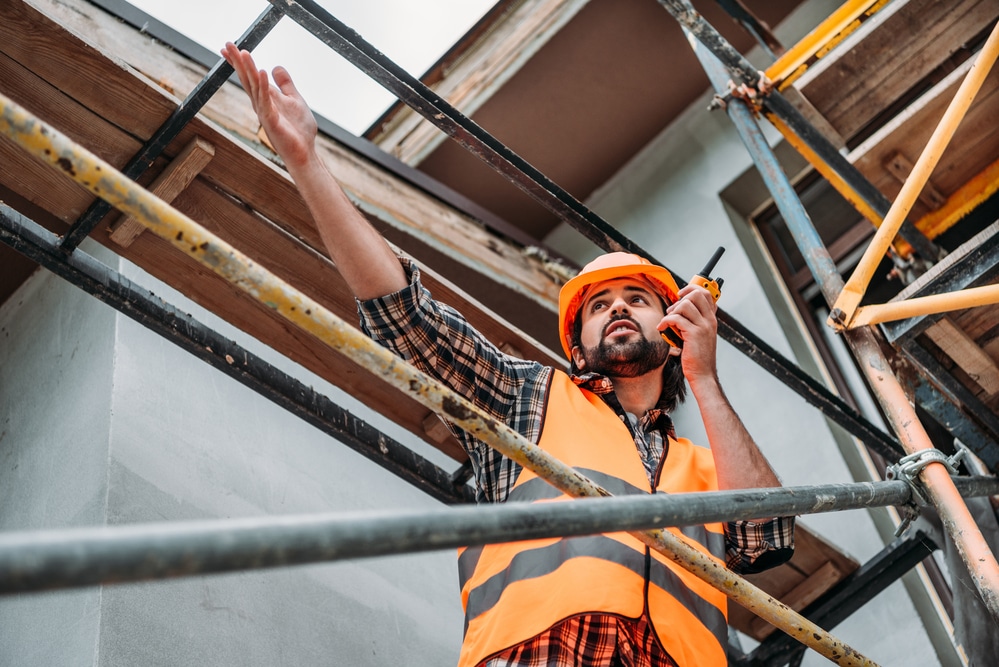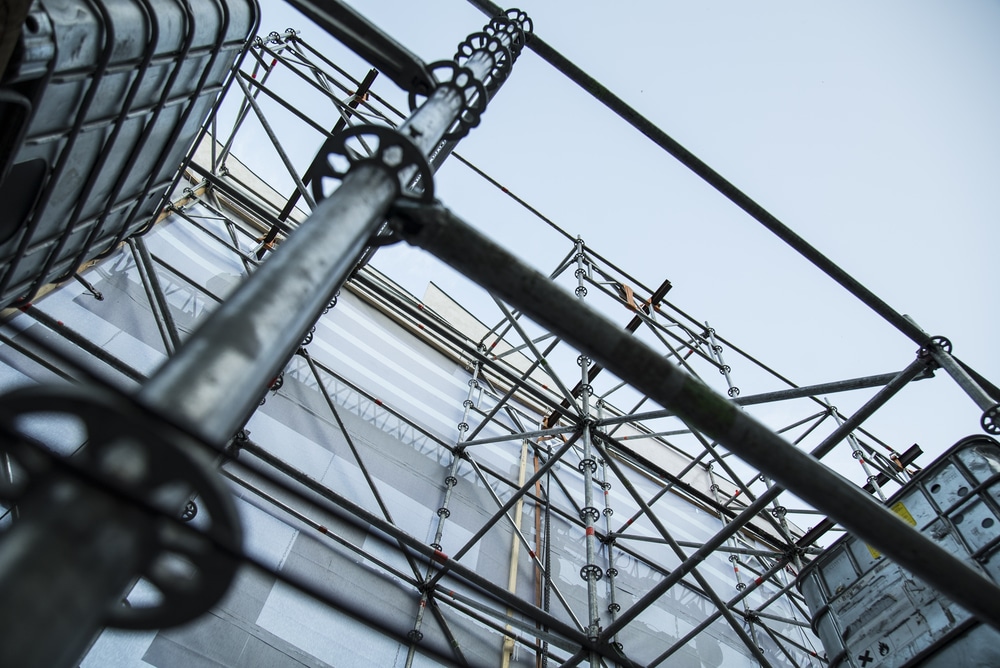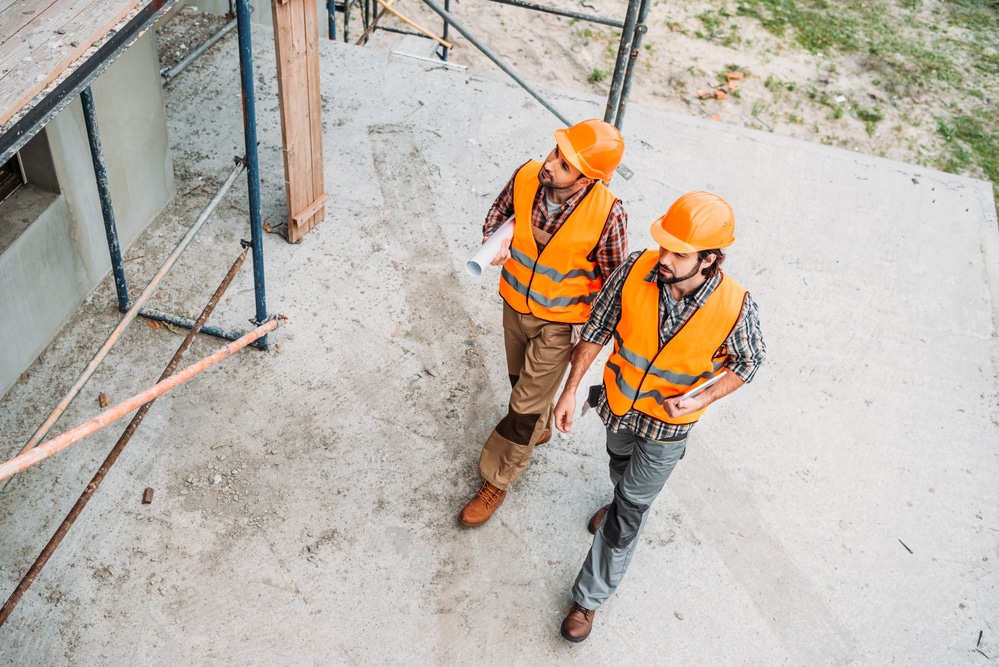The Impact of Wind Speed on Scaffolding Stability

Adverse weather conditions like high winds can seriously complicate scaffolding and other outdoor work, exacerbating numerous risk factors of an already hazardous job.
Here, we’ll discuss the impact of wind on scaffolding safety, including the effects of wind loads on a scaffolding structure and the associated industry standards.
We’ll also cover tips to help project managers determine the best accident prevention measures for dangerous windy conditions, including recommended tools and equipment to help teams stay safe on the job.
If you want to give your employees some scaffolding safety training, we have a complete course that might help.
Wind and Scaffolding
Is scaffolding OK in high winds?
Operating on scaffold systems amid strong winds requires proper precautionary measures to avoid accidents, injuries, and fatalities. Wind, heavy rain, snow, and extreme cold can be a significant cause for concern on any project involving heights and scaffolds.
High winds greatly increase the possibility of safety issues on a construction site. They exacerbate existing risk factors of working on scaffolds and put workers in increased danger of losing their balance or being struck by debris.
It’s sometimes necessary that outdoor work stops until weather conditions improve.
Wind Speed
What is the OSHA limit for wind speed on scaffolds?
Elevated work operations in winds above 20 mph must include windscreens or a personal fall arrest system (PFAS) and can only commence or proceed when a qualified person has deemed the conditions to be safe. This individual must be versed in the identification of workplace hazards (29 CFR 1926.451(f)(12)).
But how windy is too windy for scaffolding?
There’s no universal maximum wind speed limit for elevated work, but using hoists to lift workers may be prohibited if winds are over 20 mph. Operations may be halted or delayed if competent individuals deem the conditions unsafe.

Plan Ahead
It’s essential to consider the weather forecast and plan ahead of time for potential heavy winds. Always outline concrete and compliant fall protection protocols prior to beginning work.
Employers have a duty to protect their teams from work site hazards. It is their responsibility to generate detailed fall protection protocols and comprehensive safety guidelines that consider strong weather conditions.
Be Ready to Adapt
Constantly monitor weather conditions and be mindful of the equipment’s manufacturer windspeed ratings. Whenever strong winds are too much for the scaffolding system and safety equipment to bear, it’s best to avoid working until extreme weather subsides and the wind speed slows.
Implement safety measures to mitigate the specific risks that high winds place on elevated workers, including shrink wrap, scaffold sheeting, and traction material.
Scaffolding System Safety
Building codes apply to scaffold designs, so they must withstand the same elemental forces. For guaranteed stability, use additional measures like counterweights, increased buttress scaffolds, and mechanical ties. Knowing the load capacity of your scaffolding is also critical.
Assessing project risks includes studying the scaffold’s specifications and proximity to surrounding equipment and materials. Depending on the duration of their placement, certain scaffolds and other non-permanent structures benefit from wind reduction factors to reduce pressure.
Scaffold Structure
Scaffolding experts must consider the geographic location of the job site, the shapes of both the building and the scaffolding, their dimensions, and the wind pressure they can handle.
In approaching different construction projects, managers will consult with civil engineers and scaffolding experts on how the planned scaffolding structure will stand up against certain weather conditions.

Work With Scaffolding Engineers
Beyond traditional scaffolding, there are multiple types of scaffold systems, each with different benefits for unique jobs and building needs.
Engineers can analyze the construction of scaffolding equipment and materials on construction sites, along with how they are likely to be affected by cold, rain, wind, and more, with consideration given to the regional weather patterns for each project.
Risk Identification
Risks must be identified so extra precautions can be taken. Operations should utilize all available tools to secure employees and equipment, increase stability, and reduce the risk of incidents, injuries, and damage to the structure.
Risks can be exacerbated when debris netting, or scrim, is subjected to strong gusts. A net places increased pressure on each secure connection point, as it can essentially create a giant sail. If business must continue through winter with snow, additional safety requirements may call for an enclosed structure.

Risk Prevention Measures
Some common scaffolding hazard mitigation measures include guardrails, toeboards, and slip-resistant platforms.
Additionally, windspeed indicators can be installed at elevated workstations.
Qualified Teams and Leadership
Workers on scaffolds should always be well-trained, fully versed in fall protection procedures, and possess a firm grasp of applicable regulations.
Employees should learn to recognize hazards and use appropriate tools and equipment to protect themselves. They can also learn to estimate wind speed.
From minimal winds and light rain to serious and sudden weather changes, superiors must create in-depth plans and incorporate extra protection when needed.
Comprehensive Training
Employers have a responsibility to protect their teams with thorough accident prevention training. Courses should be aimed at helping workers gain a strong understanding of present and possible hazards, including the impact of wind on scaffolding safety.
Training for scaffolding workers should increase their understanding of the associated hazards and build confidence to advocate for enhanced safety measures in dangerously windy conditions.

Fall Protection: OSHA’s Fall Safety Pyramid
OSHA provides general scaffolding regulations, and there are also international and regional scaffold system training and conduct codes to consider.
Per OSHA standards, it’s mandatory for general industry personnel working at heights of over four feet to receive training and use appropriate equipment for fall protection.
For construction workers, training and protection are required for heights over six feet. (29 CFR 1910.28, 29 CFR 1926.501).
The following protocols are recommended for fall prevention when working in windy conditions:
- Completely eliminate the risk. Make available arrangements to keep employees on the ground.
- Conduct elevated work behind compliant guardrails. Toeboards can also help prevent falling objects.
- Properly use tethered restraints and always stay clipped in.
- Use a PFAS when other mitigators aren’t feasible and/or in combination with additional fall protection measures (like guardrails).
- Lastly, employ additional measures that would be insufficient on their own, such as nets and raised warning lines.
Project managers should anticipate the ways a rain storm or wind can complicate different rescue efforts if a fall occurs.
Looking After Your Workers: Professional Scaffolding Company Checklist
Scaffolding work demands focus and caution, especially in harsh weather.
Here’s a general guideline for promoting mindful, accident-free work on scaffold systems.

Guidelines for a Safe Scaffolding Project
- Stop or postpone elevated work altogether if conditions are unsafe.
- Be mindful of the forecast and current conditions.
- Provide ample breaks, particularly during challenging conditions.
- Always use proper PPE for scaffold-related work, such as hard hats, gripped gloves, and non-slip shoes.
- Adhere to all outlined protocols, regulations, and legislation.
- Practice ongoing precautionary measures and encourage multiple points of contact while working on scaffold structures.
- Only use structures and equipment as intended during normal working hours.
- Frequently inspect scaffold equipment to ensure it is stable and in good condition.
- Conduct routine safety briefings.
- Avoid constructing or using scaffolding on uneven/unstable terrain.
- Require extensive training before personnel can access the scaffold.
- Remain aware of weight limits, accounting for people, materials, equipment, and tools.
- Brace and secure scaffolds in accordance with standard regulations.
- Enforce harness requirements for scaffold work, especially during inclement weather.
- Work with a professional scaffolding company to guarantee proper installation, training, and inspections.
The Bottom Line
Buildings and scaffolds frequently encounter forceful gusts, so scaffolding engineers must rely on exact calculations to design systems that are both compliant and constructed to withstand expected wind loads.
For foreseeable weather conditions that could compromise the metal structure and other equipment, formal safety guidelines must be outlined and adhered to.
Suppose appropriate measures aren’t taken to compensate for gusts and wind loads. In that case, they can cause significant damage to the scaffold and the building it’s affixed to – not to mention endangering any nearby workers.